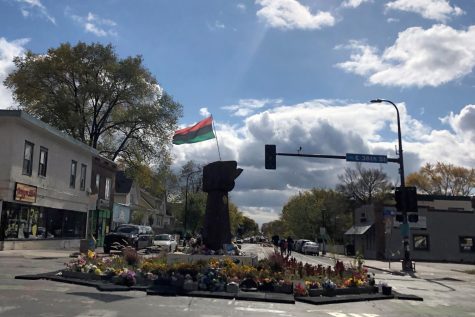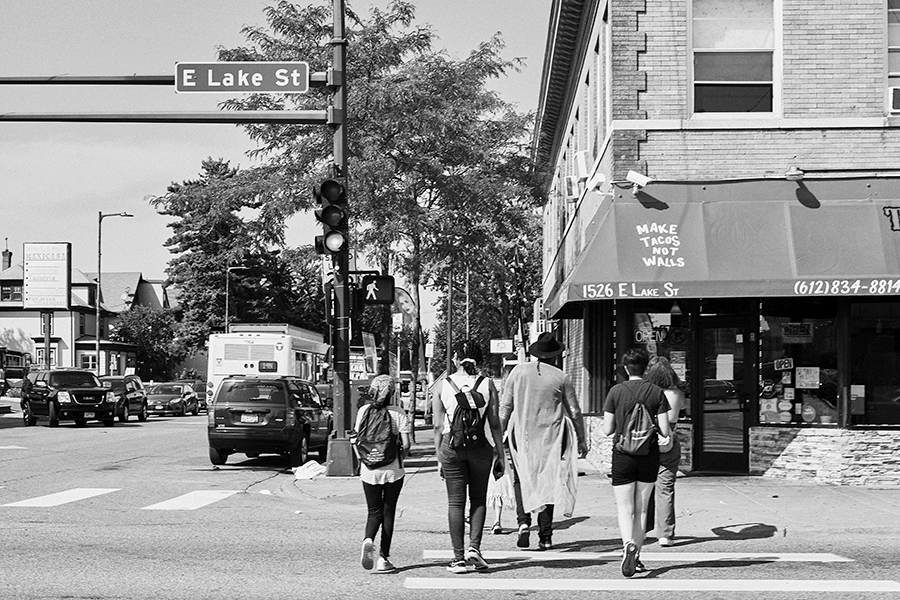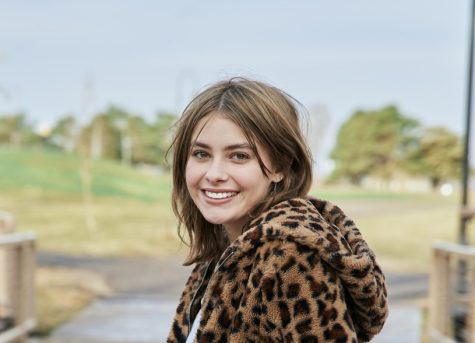Lake Street Project responses to social injustice and the pandemic
During the summer of 2020 and the start of Lake Street Project, the primary focus was workshops on Lake Street. Students walked around the area taking photos and having moments of discussion about how protesting and covid had impacted the community. Photo Courtesy of Lake Street Project.
December 22, 2020
In response to the murder of George Floyd at the hands of Minneapolis police, the protests that followed, and the covid-19 pandemic and how it affects everything we do this year, a new project was born. Lake Street Project, formerly known as Lake Street Breathe, is a collaborative student voice project created by Kari Smalkoski, Jigna Desai, Tracey Deutsch, and Kevin Murphy.
Lake Street Project (LSP) is collaborating with Minnesota Youth Story Squad and the Heritage Studies and Public History program at the U of M.
Smalkoski and Desai are co-directors and co-founders of Minnesota Youth Story Squad, as well as University of Minnesota (U of M) professors. Minnesota Youth Story Squad is a partnership program between the U of M and middle and high schools in the Twin Cities which works to amplify student voices through media-making projects.
Deutsch and Murphy are also U of M professors in the College of Liberal Arts.
So far, LSP has largely focused on documentation of what has come of the protesting that followed the murder of George Floyd. However, the topics LSP hopes to cover are diverse and intersectional, including mutual aid, houselessness, racial justice, and especially the effect the pandemic has had on all of those things.
“When we came together, it was very much in response to the murder of George Floyd, the uprisings that happened because of his death, and also covid,” said Smalkoski. “What I would say is that covid has always been central to our project, without covid I am not so sure that we would have even thought of this project in the same way.”
During the summer of 2020 and the start of LSP, the primary focus was workshops on Lake Street. “We’ve done outdoor, socially distanced workshops. We started off meeting on Lake Street and walked up and down and had moments of discussion about what has changed in our lives, what stayed the same, what it means to have an uprising and covid at the same time,” said Srija Chatterjea-Sen.

Chatterjea-Sen is a South High School graduate and 2018 University of Minnesota College of Liberal Arts graduate who is now serving with AmeriCorps, with the title VISTA (volunteers in service to America) Literacy Leader. She works for Minnesota Youth Story Squad running social media, managing partnerships, and planning youth work. She also works directly with the U of M undergraduate interns.
“One of the really cool things that has come out of this for me has been watching kids from the Northside and kids from the Southside come together to work together and share ideas and experiences,” Smalkoski said of the workshops.
“For example, we have a student who we work with who is from the Northside, has lived on the Northside her entire life, and I think it was probably one of the only times in her entire life that she even had come over to the Southside. She made a comment one day while they were walking around on Lake Street and she said ‘I can’t believe over here on the southside you have things like homelessness and police presence.’ I think she thought that the Southside would look 100 percent like the houses on Bde Maka Ska.” Smalkoski explained how interesting it was for youth to see that similar issues to those happening in their own neighborhoods were also happening across the Twin Cities.
To document the impact of riots, protests, and the pandemic on Minneapolis, LSP participants have spent time interviewing community members in the Lake Street area and photographing areas on Lake Street that were affected by protesting and covid.
“We take pictures of street art, and what has changed, and what people have left. We say street art instead of graffiti because it really is art, all the stuff that has come up from the uprising following George Floyd’s murder,” said Chatterjea-Sen.
The different projects in the works that are likely to pop up from LSP are vast. One example is the work of Andrea Manolov, a Heritage Studies and Public History major at the U of M. Manolov got involved with LSP through her track at school. “At least for me, this started back in the spring. Within Heritage Studies and Public History, I am on the public history track,” Manolov explained. “Our advisor Kevin Murphy who is a history and American studies professor at the U mentioned that he and a few of his colleagues were beginning this project.”
“Our role as Heritage Studies students was really really flexible, and I think that it was meant to be flexible. There wasn’t supposed to be a set ‘okay, this is the goal for the summer and you are going to accomplish this,’” said Manolov.
The focus of the Heritage Studies students was to document what was happening in the community as people dealt with the pandemic and the immediate response to the murder of George Floyd. They did documentation work through photography, oral history, and through joint workshops with Minnesota Youth Story Squad.
Now, Manolov is working on an exhibit, which she described as “a subproject of LSP but also meant to be a separate project in itself. Still in conversation and meant for Lake Street Project, but really operating under its own terms, which are specifically by myself and my partner for this, Acoma Gaither.”
The exhibition will look like “an outdoor, free, public exhibition, which is planning to be installed May 2021,” Manolov said.
“We want to explore the history of mutual aid and especially the way it is being defined and talked about in Minneapolis. It is really a kind of community defined notion of mutual aid,” said Manolov.
From October and continuing through May, Manolov and Gaither are hosting programs where they invited educators, artists, and Minneapolis community leaders to lead dialogue, art making, zine making that the community is invited to participate in. This program based build up will lead to an exhibition showing the work that was created.
Manolov’s project is just one example of many things coming for LSP. “There are going to be a lot of different exhibits, I think, that come up through this… I think that there is a lot that can and will happen and we will see that over the next 2 years,” said Chatterjea-Sen.
An example of what is to come is documentary filmmaking. LSP will partner with Twin Cities PBS and other media organizations to provide resources and mentorship for students to be able to create video and photography projects showcasing youth participants voices and perspectives.
The most important part of this project to Chatterjea-Sen is the element of documentation. “I think it’s super important to keep documenting history of all of this happening because we keep repeating history in a really ignorant and disgusting way and I am not interested in preserving that. I am hoping that with Lake Street Project we can kind of take some of that away and write history and remind people that racism is well and alive here, the more we pretend it isn’t, the more we are going to end up with situations like this,” she said.
Another interesting side of LSP is Native language revitalization work that the leadership term is working on with colleagues at University of Minnesota Duluth. They are creating access for community members to Indigenous languages, as well as a Tribal College with Native elders.
By creating resources like workshops, documentary making tools, and free opportunities, LSP aims to amplify youth voice and perspective in a unique way.
“One of the things that is personally frustrating for Jigna and I is that with covid, the uprisings, and the racial justice work that has been happening since George Floyd, we are not hearing a lot from youth,” said Smalkoski. She hopes that LSP can amplify youth voices in a way that popular media often does not. “We don’t hear anything in the media from high school aged students, it is all being filtered through adults, mainly politicians. That is something we are trying to change.”
The creators and participants of Lake Street Project hope this project will continue on, with long term goals of partnering with schools, specifically South, for more youth engagement and workshops. “Ms. Haug was the very first person we talked to at South High School, she was the one who really reached out to students to say ‘this is a really cool opportunity, who’s interested?’ and really helped us recruit,” said Smalkoski. There were multiple students from South involved in summer workshops, but the start of the school year has led to decreased participation with Lake Street Project from high school students.
Youth participation, especially from South students due to the proximity to Lake Street, is a huge priority for LSP. Students who have not been involved with Lake Street Project in the past should not feel like they are too late to join. Work on LSP is going to continue virtually through the winter and students are encouraged to join.
“It is really low stakes to join,” said Smalkoski. She encourages anybody with interest to connect with LSP. Additionally, students who work with LSP will be offered stipends for their time and efforts on the project.
“I invite you to come share your stories with us by just getting connected and telling us ‘this is what my capacity is,’ ‘this is what I can do, this is what I have time to do, what can I do? How can I get my story out there?’…If you have something that you want to share and you want to make space for yourself, by all means we will help,” said Chatterjea-Sen.
“For graduating seniors who are coming to the University of Minnesota, I invite y’all to connect with us, you can always shoot me or Kari an email, you can always check out our website,” said Chatterjea-Sen.
From all of the trauma that the community has been through, Chatterjea-Sen hopes that something positive can come. “I’d really like to see South Minneapolis, St. Paul, North Minneapolis, like I want to see all of us come together… I think our communities are in intense need of healing right now, especially with all the houselessness…I just want to see intense healing and shelter come from this.”
“This project has been a way to turn grief and anger and frustration, and funnel it into something really constructive for the greater good,” said Smalkoski. “When really horrendous and horrible, unjust things happen like they did with George Floyd, and you just have all this grief, anger, frustration, and energy that you don’t know what to do with, it is an amazing gift to have a project where you are working with like-minded people.”
“I think the cool thing is that this is just the beginning,” said Smalkoski. Many of the physical projects will come to fruition in 2021, since various exhibits are in the works.
The Lake Street Project website has not been rolled out yet, but for more information on LSP, refer to the Minnesota Youth Story Squad Website and Instagram:
https://www.youthstorysquad.org/
@mnyouthstorysquad








Greg Donofrio • Jan 12, 2021 at 4:26 pm
What a great article! I hope you don’t mind me including a link to it on our upcoming HSPH newsletter. Thanks!
Greg Donofrio
Director, Heritage Studies and Public History program
University of Minnesota